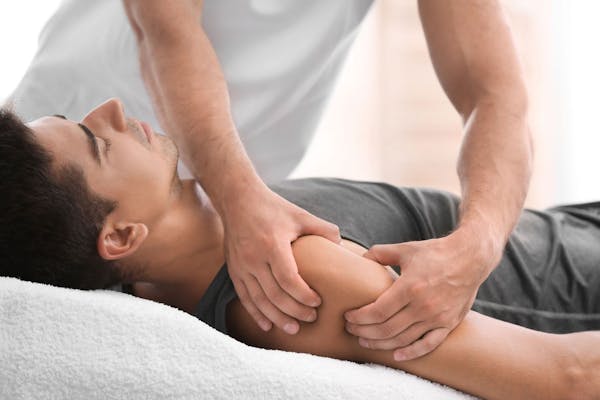
How can manual therapy help me?
If you are experiencing increased pain and stiffening in any of your joints and muscles, manual therapy is often helpful. Patients seek out this type of physical therapy for a variety of mobility issues.
For example, you may be finding it difficult to get up from a sitting or lying position, as well as bending over, without back pain and stiffness. You may also find that your neck or shoulders "freeze" and give you pain when you pursue everyday actions such as reaching for items, or driving. In fact, debilitating pain and stiffness in muscles and joints can happen virtually anywhere on your body.
What kinds of manual therapy exist?
Manual therapy is the hands-on component of physical therapy, but there are several different sub-categories within the practice of manual therapy. Each has its own benefits, depending on what the underlying problem is. Among the most widely used are:
Soft Tissue Massage
Soft tissue mobilization, or massage, focuses on muscles, ligaments and tendons. Often if a patient hasn’t had a chance to use a set of muscles due to illness, or has been injured in that area, the tissues can become scarred, and robbed of the precious fluids that promote flexibility. Soft tissue massage focuses on limbering up these damaged areas, while promoting overall wellness.
Joint Mobilization
A “restricted joint” issue often occurs after an injury, such as falling and twisting your back, or wrenching your shoulder. The injury to the joint leads to muscle spasms and restricted movement. A skilled physical therapist practices joint mobilization movements, such as a “glide and slide” of opposing bones, in order to get the joints working properly again.
Neuromuscular Techniques
At times, muscles work themselves into abnormal states, in which the muscle’s stretch reflex has difficulty relaxing itself. To treat this, physical therapists use a technique known as “strain/counterstrain” that guides the problematic muscle into positions that are “opposite” the ones at which pain and tenderness starts. Staying in this position of slight tension helps relieve the spasms by gently pulling the muscles into the opposite direction of the reflex spasms.
Where can I get manual therapy for my pain and stiffness?
Our expert physical therapists are highly qualified to practice manual therapy. With years of specialized training, our physical therapist provide gentle, hands-on therapies that address a broad range of muscle and joint conditions and injuries. This includes massage (soft tissue mobilization), joint mobilization, and neuromuscular techniques to help you feel better.
Contact us today at Kenner, LA Center to schedule an appointment!
All About Shoulder Pain: Causes and Symptoms
If you have pain in shoulder, it can be the result of many causes. However, the common causes of it are an injury of the rotator cuff or soreness of the subacromial bursa. This is a sac of fluid under the high part of the shoulder. Other causes of shoulder pain include bony abnormalities, injuries, osteoarthritis and thickening of the ligaments in the shoulder area. There may be soreness after playing a sport or lifting items. Sports enthusiasts often incur shoulder pain due to repetitive motions. Just about anything that requires you to lift the arms can cause pain or soreness. Shoulder pain can be enough to keep you up at night.
The Rotator Cuff: What It Is
The primary joint in the shoulder is formed by the shoulder blade and arm bone. It’s the joint socket that allows a wide range of motion. The rotator cuff itself is comprised of four muscles, which surround the arm bone. It keeps the shoulder steady when the arm is in motion. The rotator cuff can even be torn. The supraspinatus muscle sits on the shoulder top, and its tendon extends under the outside of the shoulder bone. Because of its location between bones, it’s a common injury. The tendon can become sore and swollen when it gets pinched between the bones. The subacromial bursa sac can also get damaged.
Frozen Shoulder: How It’s Caused
Frozen shoulder is another name for adhesive capsulitis. It’s a shoulder condition that limits the range of motion. It can be caused by long periods of inactivity, diabetes or surgery. Scar tissue may even form. As a result, the shoulder joint does not have proper space to rotate normally. Symptoms typically include stiffness, pain or swelling in the shoulder. Gradually, the ability to move the shoulder becomes less and less. Reaching for an item may even become impossible.
Physical Therapy and Rehabilitation
A physical therapist will perform a comprehensive exam along with an evaluation that includes strength and motion tests and check for any weakness in the shoulder.
Physical therapy services may include manual therapy, range-of-motion exercises, functional training, soft tissue massage and strengthening exercises. Manual techniques may include joint mobilization and manual stretching. Depending on the type of shoulder injury and the extent of the injury, physical therapy may be needed for months. Physical therapy can also help to educate patients on how to improve posture, improve gait and avoid future injury to the shoulder. Often, patients are given a home exercise program for lifelong protection and health of the shoulders.
The goal at BabinPT Physical Therapy is to provide shoulder pain relief, improve range of motion, improve flexibility and improve daily functionality.
For more information, Contact Us at Kenner, LA Center.

